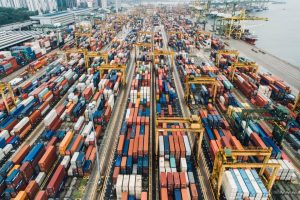
There’s no doubt about it–our world is more globalised than ever. Stop into any supermarket, department store or boutique and you’ll certainly find goods produced many thousands of miles away. In the grand scheme of things, this is a novel concept. It wasn’t until the early part of the last century that Americans began a regular system of trade with countries overseas, but now it’s like second nature.

Goods are shipped through plane, train, and automobile…oh, yeah, and maybe most importantly…cargo ships. The ships that sail into the busiest ports in the U.S. are responsible for transporting much of the world’s internationally shipped goods. The three busiest ports in the world—Shanghai, Singapore, and Shenzhen—handle nearly 100 million twenty-foot equivalent units (TEU) per year combined. That’s a whole lot of cargo!
So, what exactly are these mega-ships and aircrafts carrying? According to a report from the U.S. Department of Transportation’s Research and Innovative Technology Administration, the most commonly shipped commodities are somewhat surprising. They range from furniture to bananas to building materials. But maybe it isn’t as surprising as it sounds, since nearly 90 percent of everything we buy arrives in the U.S. via ship.
- Produce—In the U.S. and many other countries, we’re lucky enough to have a seemingly endless supply of fresh fruits and vegetables, even in the middle of a particularly harsh winter. This is all thanks to global trade! The most commonly shipped fruit is the banana. In fact, bananas are the second most commonly shipped item by weight, and account for some 3,000 metric tons of cargo per year. In 2015, $6.6 billion in fresh, dried, and frozen fruit was imported to the U.S., plus another $5.5 billion for fresh, dried, and frozen vegetables! Naturally, these commodities take up some precious cargo space.
- Furniture—It makes sense that pallets upon pallets of bananas arrive at American ports daily, since these staples require a warm, tropical climate year-round. But what about furniture? We’ve certainly got the climate for that! Still, furniture and furniture parts account for some $12 million (and 5,000 metric tons) of cargo shipped to the U.S. each year. A rise in eCommerce and a demand for more affordable furniture has sparked the rise in globally shipped furniture and furniture parts.
- Cars and Car Parts—It should come as no surprise that cars and car parts rank high on the list of popularly imported commodities, both in terms of weight and value. In the U.S., foreign cars outnumber American-made ones, and they’ve got to get here somehow. Usually, that’s via cargo ship. Motor cars account for more than $8 million and 7,000 metric tons of cargo per year.

- Electronics—Computers, TVs, smartphones, and other electronic devices make up a large percentage of what’s packed inside those shipping boxes aboard freight ships. Interestingly, where electronics companies used to favour air shipping, they’re now turning to cargo ships to get their products from one continent to another. This is because the freight shipping industry has become more reliable and faster—in part thanks to automation and, of course, technology at large—in the past several years.
- Mineral Fuel—You already know that Americans import a good chunk of their fuels from other parts of the world. And, interestingly, if we’re talking strictly value, fuel—oil, mineral wax, bitumen, and more—comes with an incredibly high price tag. About $371,300,000 worth of mineral fuel is transported globally each year. However, the International Maritime Organization (IMO) has made an effort to lower the amount of fuel shipped, as these products account for some 8 percent of maritime shipping emissions of sulfur dioxide.
- Machinery and Parts—According to the Department of Transportation’s most recent study on the matter, print machinery—including inkjet, copy, and print machinery parts—account for a major chunk of commodities shipped by value. Some years, that accounts to over $16,000,000 in goods shipped. Add another $100 million or so to that number when accounting for the nuclear reactors, boilers, and other technical equipment that arrive in the U.S. via cargo ship each year! Another $81 million is spent on electric machinery, sound equipment, TV equipment, and electronics parts.
- Clothes—When you think of that “Made in China” tag, there’s a good chance you picture it on a clothing tag. No surprise there, since a big chunk of container space is dedicated to apparel and accessories on cargo ships. These categories have extremely high vessel values. Apparel and accessories made of knit or crochet materials bring in some $36 million each year, while non-knit apparel accounts for another $28 million. In the grand scheme of things—compared with heavy machinery, for example—clothing brings a higher value but weighs less. That makes it particularly desirable for companies, who save on shipping.

- Toys and Sports Equipment—It’s not all work and no play for cargo ships. In fact, another high-value category of goods shipped via cargo ship is sports equipment. This includes articles and parts used to build arcades, and table and parlor games—$11 million worth each year! —as well as toys, scale models, puzzles, and parts. Together, toys, games and sport equipment (plus the parts and accessories used to make them) account for a $23 million vessel value each year.
- Iron and Steel—If you thought most iron and steel products were transported via railroad, you’re not wrong! According to the Association of American Railroads (AAR), the United States is the third largest producer of steel and steel-related commodities in the world. That means that American companies don’t need freight shipping to receive these goods, but it also means that American ports send a large amount of steel items to other countries every year via ocean freighter. Nearly $10 billion is spent on railroad shipping of iron and steel products each year in the U.S., and $23 million is spent on shipping it via cargo ship.

Author Bio: David Madden is an efficiency expert, as well as being the Founder and President of Container Exchanger and ExchangerHub. These companies help manufacturing and distribution companies buy and sell used industrial packing such as plastic and metal bulk containers, gaylord boxes, bulk bags, pallets, and ibc totes and industrial racks such as pallet racking, flow racks, and drive-in racks. These companies have served thousands of buyers and sellers through USA, Canada, and Mexico.

Photo links:
https://pixabay.com/en/container-van-export-travel-cargo-2568197/
https://www.pexels.com/photo/automobiles-automotives-black-and-white-black-and-white-70912/
https://www.pexels.com/photo/black-and-white-black-and-white-clothes-clothing-581339/
